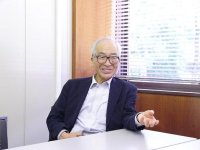 |
 |
|||||||||||||
|
|||||||||||||
|
|||||||||||||
|
Humitaka Sato, a professor emeritus of Kyoto University, is one of the most respected theoretical physicists in Japan. He served as an advisor to the Japanese government for international projects such as the International Space Station (ISS) and International Thermonuclear Experimental Reactor (ITER). In addition to his highly technical work, he authored several books that invite broad audiences to explore the world of physics. “When I began to write my books in the early 1970s, my colleagues accused me of shamelessness as an academic person going out to communicate with 'ordinary' people, getting my name into mass-communication media. At that time, the researchers or scholars thought that they should stay in an academic sanctuary far from the real world, since they thought that the real specialist could only be recognised by other specialists,” he says. Sato calls himself an 'evangelist scientist', however he is not humbling himself -- this title demonstrates his pride. “Nowadays there are so many scientists in the media. Time has finally caught up with me,” he says. One of the missions of the science community, he thinks, is to communicate with society so that people's fundamental desire for new knowledge will be satisfied. He has expressed his view on the importance of communication when he made a recommendation to the Japanese government regarding the ISS and ITER. “It will be the same for the International Linear Collider,” he said. The best thing that scientists can do is to provide as many opportunities as possible for people to be familiar with scientific topics, especially for the younger generation. “But you should not be too narrow-minded, such as trying to induce youngsters into a specific field of study so that they will choose it as their career,” Sato says. “The important thing is to present the exciting new world where millions of things are still unknown. It is also meaningful to introduce those people who have jobs that not too many people know about, such as a particle physicist working at the foreign laboratory.” Sato believes that scientists should be more aware of the influence of their research on the society and explained it is not only to provide the benefit academically or economically, but also emotionally: to inspire and encourage people. “The international aspect will again be a key message in the twenty-first century”, he says. The 'big science' of the twentieth century advanced as a result of competition between countries. From the late twentieth century on, however, international cooperation became the standard to carry out 'big science' such as the ISS and ITER. Today, travelling abroad is nothing special anymore, and the international spirit may not appear to be a very new concept. But Sato explains that real internationalisation is yet to come. “We need role models showing the way to have exciting life. And the ILC can be a good example,” he says. Many people from all around the world will be involved to implement big science projects like the ILC. “I think the ILC community should visibly promote the activities of young researchers, who are really working internationally to society. Big science is driven by people. It is the process of a struggle to carry out huge objectives by people who work, smile, fight and cry together. The spirit of international collaboration will be shared by the rest of the world if, and only if, we can share such a sense of wonder and emotions.” -- Rika Takahashi |
|||||||||||||
| © International Linear Collider |
